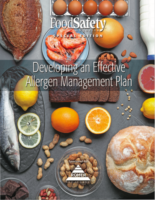Writing and Implementing an Allergen Control Plan

 Vernon Sanders Law once said, “Experience is a hard teacher because she gives the test first, the lesson afterward.” The food industry’s experience with allergens in food products appears to support Law’s observation. In recent years there has been an increasing number of food product recalls due to undeclared allergens on labels (Figure 1). The good news is that we all can learn from these recalls by identifying the most common errors that lead to the inadvertent inclusion of allergenic ingredients into finished product and the consequences that lead to undeclared allergens.
Vernon Sanders Law once said, “Experience is a hard teacher because she gives the test first, the lesson afterward.” The food industry’s experience with allergens in food products appears to support Law’s observation. In recent years there has been an increasing number of food product recalls due to undeclared allergens on labels (Figure 1). The good news is that we all can learn from these recalls by identifying the most common errors that lead to the inadvertent inclusion of allergenic ingredients into finished product and the consequences that lead to undeclared allergens.
Setting up and implementing an allergen control plan (ACP) in your food processing plant is an good way to avoid inadvertent allergen cross-contamination and thus avoid potentially damaging recalls and the adverse or even fatal physiological reactions in consumers. An ACP is a systematic method for identifying and controlling allergens, from the incoming ingredients to the final packaged product in any food processing facility. This article will outline the fundamental steps involved in developing an effective ACP in the food plant.
Controlling the Big 8
As an ancillary program to the manufacturing plant’s Hazard Analysis & Critical Control Points (HACCP) plan, the first step in developing an ACP is the assessment of allergens as part of the hazard analysis. An allergen within a food product is considered a chemical hazard. The top eight food allergens are soy, wheat, eggs, milk, peanuts, tree nuts, fish and shellfish. Once an allergen is identified by your operation as a raw ingredient or contained within a raw ingredient, control steps must be established if the product is not run on a separate line or a complete wet cleaning is performed between allergen and non-allergen containing products.
According to the Food Allergy Research and Resource Program in 2003 (www.faarp.org), possible processing errors or oversights that result in allergen-containing product contamination are as follows: inadequate cleaning of shared equipment (non-allergen containing products run after allergen containing products resulting in cross-contamination); use of rework (not using “like into like” practices); switching of ingredients (and not following up with an allergen assessment of the new ingredients); and labeling terms (using uncommon or incorrect terminology for the top 8 allergens); and frequency of HACCP plan review.
With these types of errors in mind, the ACP should address the following activities:
• Supplier monitoring
• Plant traffic flow
• Raw material storage
• Color-coding systems for utensils used with allergens
• Production scheduling
• Cleaning
• Use of rework
• Evaluation of program effectiveness
• Label review policies
• Frequency of plan review
• Documentation and documentation review of activities
• Employee education
Let’s look at each of these activities in which control steps should be implemented as part of the ACP.
Supplier Review. Food manufacturers should obtain copies of product or ingredient formulations, specification sheets or certificates of analysis (COAs) from suppliers of raw ingredients. When reviewing specifications, you should look for formulations that list ingredients without the sub-listing. For example, marshmallow whip may contain eggs, or soy sauce may contain wheat. In many instances, the final concentration of the allergen contained within another ingredient is so low that it should not cause illness. Testing to verify the quantity of allergen present will help to determine actions needed within the plant. Verify that your suppliers have an ACP.
Plant Traffic Flow. Review product flow through the production cycle. For example, look for overhead conveyors that cross one another or that cross over exposed products.
Raw Material Storage and Color-Coding Systems: Store all allergenic foods or ingredients derived from these foods in an area that is secluded or removed from non-allergenic materials. If this is not possible, require that incoming material pallets are shrink-wrapped to contain dust and to prevent other cross-contamination opportunities, such as leakage from torn bags. Carefully store partially used bags and containers of allergen-containing ingredients in segregated areas. Verify that production staff seal all partially used bags and containers.
Allergen identification is a helpful tool for all employees in a production facility. All raw materials that are allergens should be labeled with a tag that states “allergen.” This will help to avoid substitution mistakes (i.e., wheat flour for soy flour). A color-coded tag also may be used. It is an excellent idea to place color-coding charts throughout the production area, especially above all wall-mounted equipment and near storage areas for easy identification by plant personnel. Store allergenic compounds on the bottom of racks or nearest to the floor to avoid spilling of allergenic ingredients to items below.
Dedicated scoops, utensils and bins used for specific ingredients also assist in keeping allergens segregated. By combining both bright colors and words, you can reach employees that may be color blind (words on labels included) or those who speak English as a second language (color coding).
Production Scheduling & Cleaning. There are main two methods used to control allergens within the plant. The first method involves producing the allergen-containing product as the last product on a production line. If all products manufactured contain the same allergen, a label declaration is enough to control the allergen. However, if only one product produced contains an allergen, run that product last. If one product does not contain an allergen, but the rest of the products do, run this product first after a complete wet cleaning procedure or perform a wet cleaning procedure between the allergen-containing product run and non-allergen-containing product run.
For example, a bakery will use wheat as one of its main ingredients. If wheat is included as an ingredient in every item manufactured and is declared on every label, it is not very likely that wheat is an allergen of concern for the bakery. However, other products made in the bakery may contain walnuts or soy flour. Any breads or bakery products containing walnuts or soy flour must be produced last to avoid cross-contamination. Also, it is important to look for similar types of products where some contain an allergen and others do not. For example, a bakery may make three kinds of donuts—raised, fried and old-fashioned. If one of the mixes contains dried eggs and the others do not, there is a potential for cross-contamination or for substituting the wrong raw material during manufacture.
The second method used for controlling allergen cross-contamination is to implement a wet cleaning procedure prior to or following the run of an allergen-containing product on a particular line. It is the protein component within the food that is responsible for the immunological symptoms of an allergic reaction in humans. As such, the goal of the processor is complete removal of allergenic proteins. When opting for the wet cleaning method, first assess the food items that are processed on shared equipment. An example is peanut butter cookies, pecan cookies and oatmeal-walnut cookies. All of these probably would be mixed in the same mixer and baked on the same sheets. Each product contains a different allergen (peanuts, pecans, walnuts), necessitating the implementation of scheduling or cleaning procedures. It is important to note that each tree nut is a distinct and individual allergen. Do not schedule all tree nut-containing products together without a wet cleaning procedure in between. If a wet clean is not possible between runs, the first portion of a next run should be discarded. When cleaning operations are not performed between allergen and non-allergen containing products or between different allergen containing products, a parts-per-million (ppm) analysis must be conducted to establish the safety of the products that do not list allergens on the label. If a product contains allergenic compounds at a level of 5 ppm or greater and this allergen is not listed on the label, allergenic symptoms may be invoked in extremely sensitive individuals.
The amount of discarded product must be determined by the use of testing to verify that the level of residual protein is less than 5 ppm before switching over to packaging the new line. If there is not a test kit available for the type of allergen involved, consult an outside testing facility to perform the tests. When production scheduling and cleaning operations are not performed between allergen containing production runs, allergen testing must be performed.
Test results are to be reviewed by management and them written policies established and communicated to production staff. For example, testing may indicate that the first two minutes’ worth of product must be discarded for the dilution of an allergen to a safe level in a non-allergen containing product produced on the same line after an allergen containing product. Verification must be made that a full two minutes’ worth of production is indeed being discarded. Then document, document, document.
Rework. When using reworked products, always add “like into like.” Reworked products should always be labeled with tags that indicate which products contain allergens. The reworked products containing allergenic ingredients must be stored in areas separate from those products that do not contain allergens. Utensils should be color-coded for use with allergen-containing products, and these should not come into contact with non-allergen-containing products. If at all possible, rework product back into the same production run.
Evaluation of Program Effectiveness. Changes in raw materials, suppliers and customer demands result in the need for continuous reevaluation of the effectiveness of the ACP. Incorporating routine auditing practices, both for your suppliers’ and your own in-plant operations, is a key component in continuously verifying that the program is working effectively.
Label Review Policies. Develop a system for maintaining labels that are placed on foods containing allergens in easy-to-identify areas. Discard all old labels. Conduct a thorough review of the current recipes and match them with the labels used. An excellent method to help manage allergen labeling is to build a book containing raw material specifications, formulations and finished product labels. When a raw material ingredient statement changes, you should be able to cross-reference with the finished product labels and understand what products and labels would be affected by the change.
Frequency of Plan Review. Allergen plans should be reviewed during an annual HACCP validation. Line items on internal audits should include specific allergen policies (scheduling, utensil usage, cleaning, raw ingredient segregation and color coding). The internal audits should be placed on the agenda and reviewed during monthly HACCP meetings.
During internal audits, review documentation to assure that all practices written within the allergen policy are being performed. Internal audits should be conducted on a monthly basis. Further discussion of policies should be discussed during monthly HACCP meetings.
Documentation and Documentation Review of Activities. Say what you are going to do, do what you say and prove it with documentation. If it is not documented it is not considered done. Production schedule and sanitation checkoff sheets must all be filled out and reviewed by a manager (signed and dated) to complete the records for allergen policies.
Employee Education. Allergen education may be easily incorporated into good manufacturing training periods. As always, after education sessions documentation of the employee by signature, date, trainer and materials covered should be available for review. Allergen education should be conducted on a company-wide basis.
Knowledge is Power
“If knowledge can create problems, it is not through ignorance that we can solve them,” wrote author Isaac Asimov. With a definite trend in product recalls associated with undeclared allergens in finished product, the best course of action to control these chemical hazards is to start. If you have not already looked at food allergens in your facility, the time is now.
Ultimately, an effective allergen control plan requires the understanding and buy-in of all food production staff. A single department is not responsible for the maintenance of an ACP. Corporate managers, plant managers, quality control, production, cleaning and sanitation, and purchasing departments are all responsible for the development, implementation and upkeep of an ACP.
Virginia Deibel, Ph.D., is chief executive officer of Brain Wave Technologies, Inc., a food microbiology research and consulting firm where she utilizes her 16 years’ experience in the food microbiology industry to provide clients with technical expertise analyzing, streamlining and improving all aspects of food production. Deibel and her team of scientists work out of a microbiology laboratory in Madison, WI. Her firm’s range of services include customized food research projects, food safety seminars, HACCP, GMO testing, plant inspections and all aspects of recall prevention and recall management planning. Elected to serve on the executive board of the Wisconsin Association of Milk and Food Sanitarians, Deibel also is a member of the International and Wisconsin Association of Milk and Food Sanitarians, American Society of Microbiology, Institute of Food Technologists (IFT), Wisconsin IFT, where she serves on the board as treasurer, International Association of Food Protection and American Dairy Science Association.
Laura Berkner Murphy is director of regulatory compliance and education at Brain Wave Technologies, where she applies her expertise in the areas of regulatory compliance, labeling standards, technical sales and problem solving. She also delivers educational seminars in food safety, Good Manufacturing Practices, HACCP and food allergens. Her allergen training talk at the Wisconsin Association of Milk and Food Sanitation Workshop last year won wide acclaim from those in the meat, dairy, seafood and appetizer industries.
>
Looking for a reprint of this article?
From high-res PDFs to custom plaques, order your copy today!







.webp?t=1721343192)
